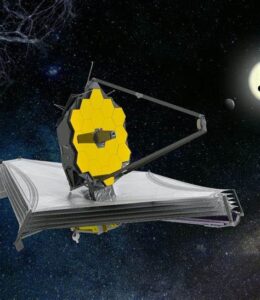Launched in December 2021, the James Webb Space Telescope (JWST) is designed primarily to conduct infrared astronomy. The telescope is named after James E. Webb, past administrator of NASA from 1961 to 1968 during the Mercury, Gemini, and Apollo space programs. The telescope is the successor of the Hubble Space Telescope as NASA’s flagship mission in astrophysics (study of astronomy). It deployed successfully for safe transport into space about one million miles from Earth. Its lifetime is estimated at 20 years.

James Webb Space Telescope
The coalition group of NASA, European Space Agency, and the Canadian Space Agency planned JWST in 1996 and had various delays with a final cost of $10 billion. Was it worth the cost? Since July, thousands of images have been sent and viewed with extreme clarity of our ever-expanding universe. In comparison, Hubble cost us $9 billion to date and still working after 31 years.
With its larger 21-foot gold coated mirror and special infrared instruments, JWST can detect objects up to 100 times fainter than Hubble and detect objects much earlier in the universe, back to about 180 million years after the Big Bang.
JWST has four key goals: 1) to search for light from the first stars and galaxies that formed in the universe after the Big Bang, 2) to study galaxy formation and evolution, 3) to understand star formation and planet formation, & 4) to study planetary systems and the origins of life.
The universe is estimated to be at least 13.9 billion years old. In comparison, our solar system as part of the Milky Way galaxy is estimated to be 4.5 billion years old. It is hoped JWST can discover the origin of the universe by looking at the furthest stars and billions of galaxies to determine their composition and age. Regardless, the three space agencies have many experiments planned to determine our origin
